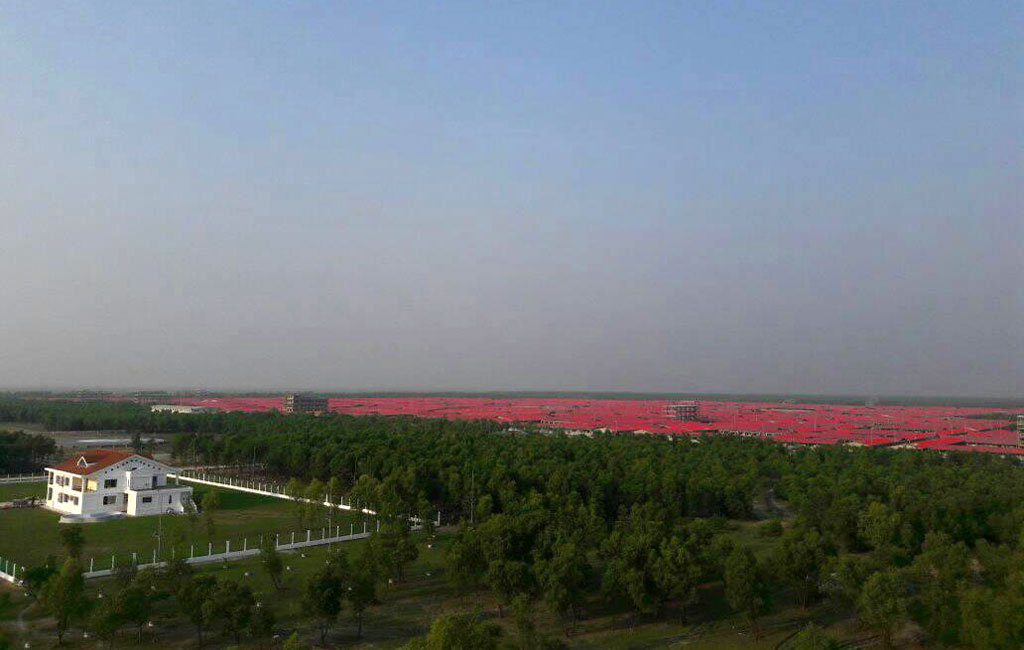[Analytics] What do Rohingyas think about Bhashan Char?

This photo, collected from project official Atikul Islam’s Facebook page, shows the housing project under construction at Bhasan char
The displaced Rohingya population prefers living in the cramped and squalid refugee camps of Cox’s Bazar, rather than living in a potentially better-sheltered and relatively more comfortable facility on Bhasan Char. Sushanto Biswas specially for the Dhaka Tribune.
The Bangladesh government is almost at the final stage of relocating 100,000 Rohingyas who were forcefully driven away from their land in a Myanmar army crackdown.
However, the unwillingness of the Rohingyas to relocate to the remote island is delaying the relocation plan.
Construction has already been carried out at Bhasan Char, previously known as Thengar Char, a river island which emerged twenty years ago at the mouth of the Meghna River.
Prime Minister Sheikh Hasina is set to formally inaugurate the housing complex on the flood- prone isolated island soon.
However, many Rohingyas disagree with the relocation plan. Speaking with the Dhaka Tribune, they said they want to continue living in the refugee camps of Cox’s Bazar, instead of on Bhasan Char in Noakhali.
The assurance of a relatively-comfortable life on the remote island, made by the Bangladesh government, is not enough to convince them. Most Rohingya refugees are unwilling to relocate there as they fear death by starvation, floods, and a lack of humanitarian aid.
An exclusive video, released in November by the Guardian, also showed a number of “prison-like units” built for Rohingyas on the remote silt island.
Bhasan Char project at a glance
The Executive Committee of the National Economic Council (Ecnec), in November 2017, approved a Tk2312.15 crore project to provide temporary shelter for Rohingya refugees on Bhasan Char.
The island is located 21 nautical miles from Noakhali, 11 nautical miles from Jahajir Char, 4.2 nautical miles from Sandwip, 28 nautical miles from Patenga, and 13.2 nautical miles from Hatiya. Motor-run boats are the only mode of travel to this area.
Under project “Ashrayan-3,” the necessary infrastructure to house 100,000 displaced Myanmar citizens, and other island facilities, are being constructed on Bhasan Char.
Almost 80% of the construction of houses and cyclone shelters has already been completed, and the island will have flood protection embankments, secure homes, and administrative buildings.
‘A death trap’
Speaking to our correspondent at Lambasia Rohingya refugee camp in Ukhiya upazila of Cox’s Bazar, a number of Rohingyas rejected the idea of moving to Bhasan Char.
Hamid Hussain, a Rohingya man in his sixties, living in the camp for almost five years, said: “If the Bangladesh government wants to improve our quality of life, then they should do it here in Cox’s Bazar where all the Rohingya population is already living.
“The new place is a death trap. Someone told me that island might go underwater anytime. There is also slim chance of humanitarian services of non-government organizations (NGOs) on that remote island.”
Expressing his concerns, Hamid added: “There will be no NGOs on Bhasan Char, which means there will be no humanitarian support or activities, and no monitoring.”
At present, many international and local NGOs are working at the Rohingya camps in Cox’s Bazar, providing much-needed food, shelter, healthcare, and other aid to the refugees.
Hamid’s son Jamil Hussain said his father was a farmer in Myanmar, but they are now unemployed.
Discussing his life in the camp, Jamil said: “It has been over a year since we have taken shelter in Bangladesh. During this period, my father has set up a shop where he can earn Tk200 to Tk300 per day.
“Life is difficult, but we are well aware this is the best we can do right now. So, we do not want to leave this camp. In fact, we will not go anywhere except our own country.”
‘We will drown’
Abdus Salam, a majhi –a title given to a Rohingya leader – of the Lambasia camp said they had already discussed relocation among themselves,and almost everyone is scared about the idea.
He told the Dhaka Tribune: “These Rohingyas have been here for a long time, and they do not want to change their place of residence again. It takes 3 hours to reach Bhasan Char by boat. We do not want to live in such an isolated place.
“Will an adequate amount of food, necessary facilities, and security be available there? There is so much water, we will drown eventually. It is better to die here, than to move to Bhasan Char.”
When asked why the Rohingyas are rejecting the possibly of a better life on Bhasan Char, a Rohingya woman named Shekufa Begum said: “The camp in Cox’s Bazar is very close to my homeland Myanmar, and I can return there if the situation improves.
“But in Bhasan Char, we face the risk of this island sinking to the depths. Locals and other Rohingyas have warned me about it.”
Refugee Relief and Repatriation Commissioner Mohammad Abul Kalam, who is supervising the refugee camps in Cox’s Bazar, said the Prime Minister’s Office has been instructed to select some majhis and to bring them to Bhasan Char for an orientation.
The majhis will be given a tour of the island and its facilities so they can inspire Rohingyas living in the Cox’s Bazar camps to relocate.
“We will take a Rohingya delegation to Bhasan Char as soon as possible and will show them the facilities,” said Kalam, hoping they will be more willing to relocate after a tour.
On August 25 last year, the Myanmar army launched a crackdown on the Rohingya minority, forcing over 700,000 of the ethnic community to cross the border and take shelter in overcrowded refugee camps at Cox’s Bazar.